“Dominion” was one of the first board games I purchased when “Dad’s Gaming Addiction” was but a mere speck on the horizon. The idea of building your deck during the game rather than before it was definitely a foreign concept to me at the time. “Trains”, surprisingly enough, plays a lot like “Dominion” in that you’ll be building a deck of cards as you play by purchasing them from the available supply. At the same time, you’ll be constructing rails/routes on the map, similar to that of “Ticket to Ride”. It’s as almost as if “Dominion” and “Ticket to Ride” went out on a date and got a little bit too tipsy during the obligatory nightcap (close your eyes, kids). At any rate, I wanted to see if the game was any good, seeing as how I am a fan of both games. The results may (or may not) surprise you. Before we begin, I’d like to quickly thank David Trudeau from Alderac Entertainment Group for providing me with a free press copy.
Components
Board – This double-sized board features a map of Tokyo on one side and Osaka on the other.
Rail Tokens – These cubed tokens come in four colors (one for each player in the game). Players will be placing these on the board to represent their individual railways, as they are constructed.
Scoring Tokens – Four of the above mentioned cubes (one of each color) serve as the scoring tokens. These are moved along the scoring track along the perimeter of the board as players score points.
Station Tokens – Thirty white station tokens are included in the box and are built on cities so that players may have the opportunity to score points.
Cards – There are over five hundred cards (yes, five hundred), all of which belonging to a particular deck (like in “Dominion”). Not all of the decks are used in a single game. Thirty randomizer cards are included to help players draft the non-standard decks that will be used in any particular game.
Setup & Gameplay
Players will choose a side of the board and pick one of the four player colors. Once done, they’ll place one of their cubes on the “0” and keep the rest in front of them. Each player will receive a “starter deck” of ten specific cards, shuffle them, and places them in a face-down draw pile. Next, players will need to seed the supply with decks of cards. Eight particular decks are used in every single game while another eight are randomized (via the randomizer cards). For an easier game, the manual suggests including the landfill deck among those eight random decks. The person who most recently traveled by train goes first, though before that happens, each player draws five cards to form their starting hand and places one rail cube/token as a starting point.
The game is played over a series of turns, with play proceeding clockwise around the table. On a player’s turn, they’ll play cards from their hand in order to perform various actions. Some cards grant the owner money, which they can then use for that turn only to purchase cards from the available supply (though they won’t be able to use these new cards on that turn). Other cards allow the player to lay rail, place stations, collect or remove waste, and etc. Once the player is done performing actions, they’ll take all of the cards they purchased and played (along with those still left in their hand) and place them into a discard pile. They’ll then draw five more cards for use on their next turn.
While I won’t go into all of the nitty-gritty details, I do want to touch on the highlights. For one, waste cards do not benefit the user in any way, but some of the actions you perform will require you to draw them. In essence, the more you build and expand, the more your deck becomes cluttered with unusable cards. Some cards (like the landfill cards) combat this. Another thing worth noting is that not all spaces have the same cost in terms of placing rails. Fields have no extra cost, while mountains require two extra points of money. While players can share spaces, the cost of building a rail goes up for every existing rail present. Finally, stations are placed on city spaces and serve to provide players with extra points at the game’s end for the rails they may have there.
The game can end a number of ways. If four of the card stacks in the supply are depleted, if any players uses all of their rail cubes/tokens, or if all station tokens have been placed, then the game ends. While players may earn points during the game (by playing certain cards), they will also be awarded points for any rails they have on cities with stations as well as for gold-colored cards in their deck (wherever they happen to be at the time). The person with the most victory points after it is all said and done, wins!
The above doesn’t cover all of the rules found in the manual, but should give you an idea as to how the game is played. For more information, you can view the manual here:
http://www.alderac.com/images/2013/03/Trains_Rulebook.pdf
The Review
I had no real issue with the components, though if I had to nit-pick, I’d have to bring up the fact that the so-called mountain spaces on the board look like forests…I’m honestly not sure why the developers labeled them as such. I did like the fact that cards were color-coded based on function (blue for money, green for rail laying, etc.), though some action cards provide money as well so you’ll need to pay attention. It would have been nice if these cards could have been color-coded in both of the appropriate colors, just so players can easily pick out a card’s dual function. The box insert and the card organizers did an OK job in holding the components, but I would have prefered slots as featured in “Dominion’s” box insert. Again, these are minor inconveniences.
The learning curve was relatively light, but that’s mainly because I’ve played “Dominion” before. I’ll go as far as to say that if you’ve played “Dominion” and understand how deck building games like this work, that you’ll be three-fourths of the way to already learning how to play. The most difficult aspect lies in the strategy and how to use the cards you have to your advantage…obviously this takes time. Vinnie (12) had no trouble with the rules after I have him a brief primer and our first game was for the most part painless. The cards are fairly icon-heavy, so I had to break every now and again to look up their meaning.
Some of the cards seemed to be a bit more powerful than others, but then again, we haven’t spent years playing the game. The tourist train is one such example and can be purchased like any other card in the supply (assuming it was picked during the random draft process). The kicker is that it, when played, awards that player a victory point. Own enough of them and you’ll climb the victory point track like no one’s business. While it is important to lay out tracks in a way that intersects stations in play for points at the game’s end, I felt like I was forced into buying tourist train cards just to keep up with the competition. Luckily, this deck isn’t one of the eight required decks to have during game setup…if it gets picked during a draft, you can simply pick something else if you so choose.
Along those lines, the game offers a TON of different ways to play. I mean, c’mon…five-hundred plus cards? There’s certainly a lot of replay value here since eight of the sixteen decks are randomized during game setup. On the other hand, the game is mod-friendly in that folks can pick out their favorite decks and forgo the random draft. While the general gameplay mechanics are easy to follow (you’re playing up to five cards every turn), the strategies will change depending on the decks/cards available for purchase in the supply. “Dominion” offers this flexibility as well, so those of you who are familiar with that game will be just as pleased with “Trains” in that regard.
In the end, “Trains” exceeded my expectations and then some. I admit I’m a big fan of railroad themed games (“Ticket To Ride”, “Railroad Tycoon”, etc.) to begin with, but the overall gameplay in “Trains” is sound and satisfying. While I seemed like I was nitpicking a bit in the opening paragraph of this review, the positives certainly outweigh the negatives. I can easily recommend this to most gamer families, though the casual folks may need some extra time to get acquainted with the mechanics of in-game deck building.
Final Verdict: 8/10
—
You can learn more about and purchase “Trains” by visiting the following websites:
http://www.alderac.com/trains/
—

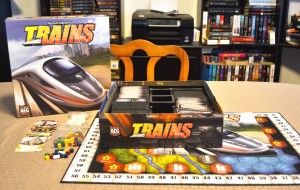
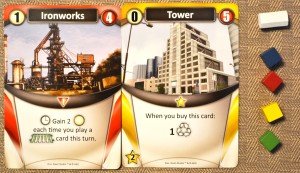
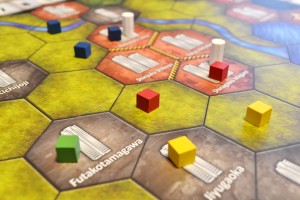
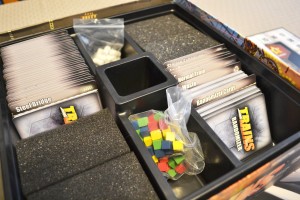
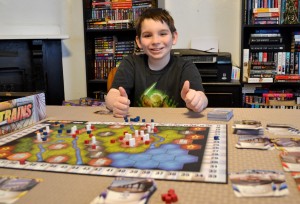
I follow your reviews and most of the time agree with your veredict, I prefer family style games, try to stay away from heavy RPG. The one suggestion I´ll make is to use a mic when far from the camera, like at the begining of this one, it sounds far.
Thanks for sharing these games.
My DSLR camera doesn’t support a microphone…thanks though!